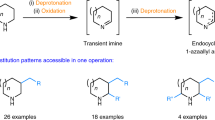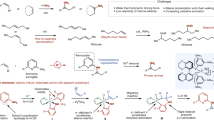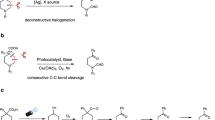Abstract
Primary aliphatic amines are important building blocks in organic synthesis due to the presence of a synthetically versatile NH2 group. N-functionalization of primary amines is well established, but selective C-functionalization of unprotected primary amines remains challenging. Here, we report the use of CO2 as an activator for the direct transformation of abundant primary aliphatic amines into valuable γ-lactams under photoredox and hydrogen atom transfer (HAT) catalysis. Experimental and computational studies suggest that CO2 not only inhibits undesired N-alkylation of primary amines, but also promotes selective intermolecular HAT by an electrostatically accelerated interaction between the in situ-generated negatively charged carbamate and the positively charged quinuclidinium radical. This electrostatic attraction overwhelms the inherent bond dissociation energies which suggest that HAT should occur unselectively. We anticipate that our findings will open up new avenues for amine functionalizations as well as selectivity control in HAT reactions.
This is a preview of subscription content, access via your institution
Access options
Access Nature and 54 other Nature Portfolio journals
Get Nature+, our best-value online-access subscription
$29.99 / 30 days
cancel any time
Subscribe to this journal
Receive 12 print issues and online access
$259.00 per year
only $21.58 per issue
Buy this article
- Purchase on Springer Link
- Instant access to full article PDF
Prices may be subject to local taxes which are calculated during checkout




Similar content being viewed by others
References
He, J., Wasa, M., Chan, K. S. L., Shao, Q. & Yu, J.-Q. Palladium-catalyzed transformations of alkyl C–H bonds. Chem. Rev. 117, 8754–8786 (2017).
Roberts, B. P. Polarity-reversal catalysis of hydrogen-atom abstraction reactions: concepts and applications in organic chemistry. Chem. Soc. Rev. 28, 25–35 (1999).
Qvortrup, K., Rankic, D. A. & MacMillan, D. W. C. A general strategy for organocatalytic activation of C−H bonds via photoredox catalysis: direct arylation of benzylic ethers. J. Am. Chem. Soc. 136, 626–629 (2014).
Jeffrey, J. L., Terrett, J. A. & MacMillan, D. W. C. O–H hydrogen bonding promotes H-atom transfer from α C–H bonds for C-alkylation of alcohols. Science 349, 1532–1536 (2015).
Shaw, M. H., Shurtleff, V. W., Terrett, J. A., Cuthbertson, J. D. & MacMillan, D. W. C. Native functionality in triple catalytic cross-coupling: sp 3 C–H bonds as latent nucleophiles. Science 352, 1304–1308 (2016).
Le, C., Liang, Y., Evans, R. W., Li, X. & MacMillan, D. W. C. Selective sp 3 C–H alkylation via polarity-match based cross-coupling. Nature 547, 79–83 (2017).
Prier, C. K., Rankic, D. A. & MacMillan, D. W. C. Visible light photoredox catalysis with transition metal complexes: applications in organic synthesis. Chem. Rev. 113, 5322–5363 (2013).
Schultz, D. M. & Yoon, T. P. Solar synthesis: prospects in visible light photocatalysis. Science 343, 1239176 (2014).
Beatty, J. W. & Stephenson, C. R. J. Amine functionalization via oxidative photoredox catalysis: methodology development and complex molecule synthesis. Acc. Chem. Res. 48, 1474–1484 (2015).
Nakajima, K., Miyake, Y. & Nishibayashi, Y. Synthetic utilization of α-aminoalkyl radicals and related species in visible light photoredox catalysis. Acc. Chem. Res. 49, 1946–1956 (2016).
Kubiak, R., Prochnow, I. & Doye, S. Titanium-catalyzed hydroaminoalkylation of alkenes by C–H bond activation at sp 3 centers in the α-position to a nitrogen atom. Angew. Chem. Int. Ed. 48, 1153–1156 (2009).
Bexrud, J. A., Eisenberger, P., Leitch, D. C., Payne, P. R. & Schafer, L. L. Selective C–H activation α to primary amines. Bridging metallaaziridines for catalytic, intramolecular α-alkylation. J. Am. Chem. Soc. 131, 2116–2118 (2009).
Das, S., Kumar, J. S. D., Thomas, K. G., Shivaramayya, K. & George, M. V. Photocatalyzed multiple additions of amines to α,β-unsaturated esters and nitriles. J. Org. Chem. 59, 628–634 (1994).
Adenier, A., Chehimi, M. M., Gallardo, I., Pinson, J. & Vilà, N. Electrochemical oxidation of aliphatic amines and their attachment to carbon and metal surfaces. Langmuir 20, 8243–8253 (2004).
Largeron, M. Protocols for the catalytic oxidation of primary amines to imines. Eur. J. Org. Chem. 5225–5235 (2013).
Calleja, J. et al. A steric tethering approach enables palladium-catalysed C–H activation of primary amino alcohols. Nat. Chem. 7, 1009–1016 (2015).
Willcox, D. et al. A general catalytic β-C–H carbonylation of aliphatic amines to β-lactams. Science 354, 851–857 (2016).
Dell’Amico, D. B., Calderazzo, F., Labella, L., Marchetti, F. & Pampaloni, G. Converting carbon dioxide into carbamato derivatives. Chem. Rev. 103, 3857–3897 (2003).
Chu, J. C. & Rovis, T. Amide-directed photoredox-catalysed C–C bond formation at unactivated sp 3 C–H bonds. Nature 539, 272–275 (2016).
Choi, G. J., Zhu, Q., Miller, D. C., Gu, C. J. & Knowles, R. R. Catalytic alkylation of remote C–H bonds enabled by proton-coupled electron transfer. Nature 539, 268–271 (2016).
Peeters, A., Ameloot, R. & De Vos, D. E. Carbon dioxide as a reversible amine-protecting agent in selective Michael additions and acylations. Green Chem. 15, 1550–1557 (2013).
Huang, Z., Wang, C. & Dong, G. Catalytic C(sp 3)–H arylation of free primary amines with an exo directing group generated in situ. Angew. Chem. Int. Ed. 55, 5299–5303 (2016).
Liu, Y. & Ge, H. Site-selective C–H arylation of primary aliphatic amines enabled by a catalytic transient directing group. Nat. Chem. 9, 26–32 (2017).
Wu, Y., Chen, Y.-Q., Liu, T., Eastgate, M. D. & Yu, J.-Q. Pd-catalyzed γ-C(sp 3)−H arylation of free amines using a transient directing group. J. Am. Chem. Soc. 138, 14554–14557 (2016).
Lee, M. & Sanford, M. S. Platinum-catalyzed, terminal-selective C(sp 3)−H oxidation of aliphatic amines. J. Am. Chem. Soc. 137, 12796–12799 (2015).
Howell, J. M., Feng, K., Clark, J. R., Trzepkowski, L. J. & White, M. C. Remote oxidation of aliphatic C−H bonds in nitrogen-containing molecules. J. Am. Chem. Soc. 137, 14590–14593 (2015).
Davis, H. J. & Phipps, R. J. Harnessing non-covalent interactions to exert control over regioselectivity and site-selectivity in catalytic reactions. Chem. Sci. 8, 864–877 (2017).
Lowry, M. S. et al. Single-layer electroluminescent devices and photoinduced hydrogen production from an ionic iridium(iii) complex. Chem. Mater. 17, 5712–5719 (2005).
Liu, W.-Z. & Bordwell, F. G. Gas-phase and solution-phase homolytic bond dissociation energies of H−N+ bonds in the conjugate acids of nitrogen bases. J. Org. Chem. 61, 4778–4783 (1996).
Caruano, J., Muccioli, G. G. & Robiette, R. Biologically active γ-lactams: synthesis and natural sources. Org. Biomol. Chem. 14, 10134–10156 (2016).
Masuda, K., Ito, Y., Horiguchi, M. & Fujita, H. Studies on the solvent dependence of the carbamic acid formation from ω-(1-naphthyl)alkylamines and carbon dioxide. Tetrahedron 61, 213–229 (2005).
Finn, M., Friedline, R., Suleman, N. K., Wohl, C. J. & Tanko, J. M. Chemistry of the t-butoxyl radical: evidence that most hydrogen abstractions from carbon are entropy-controlled. J. Am. Chem. Soc. 126, 7578–7584 (2004).
Barham, J. P., John, M. P. & Murphy, J. A. Contra-thermodynamic hydrogen atom abstraction in the selective C–H functionalization of trialkylamine N–CH3 groups. J. Am. Chem. Soc. 138, 15482–15487 (2016).
Acknowledgements
The authors acknowledge financial support from NIGMS (T.R., GM125206), as well as partial support from the Catalysis Collaboratory for Light-activated Earth Abundant Reagents (C-CLEAR), which is supported by the National Science Foundation and the Environmental Protection Agency through the Network for Sustainable Molecular Design and Synthesis programme (NSFCHE-1339674, T.R.). Calculations were performed with computing resources granted by JARA-HPC from RWTH Aachen University under project ‘jara0091’. The authors thank J. Owen (Columbia University) for the use of his fluorometer.
Author information
Authors and Affiliations
Contributions
T.R. and J.Y. conceived the concept. T.R. directed the investigation. J.Y. performed the experiments and analysed the data. I.K. and F.S. carried out computational studies. J.Y., T.R., I.K. and F.S. collated the data, discussed the implications and prepared the manuscript.
Corresponding authors
Ethics declarations
Competing interests
The authors declare no competing interests.
Additional information
Publisher’s note: Springer Nature remains neutral with regard to jurisdictional claims in published maps and institutional affiliations.
Supplementary information
Supplementary information
Materials and methods, synthesis and characterization of products, Supplementary Figures 1–13, Supplementary Tables 1–6, NMR Spectra and computational details
Computational data
All computed structures that are included in the main Supplementary information file
Rights and permissions
About this article
Cite this article
Ye, J., Kalvet, I., Schoenebeck, F. et al. Direct α-alkylation of primary aliphatic amines enabled by CO2 and electrostatics. Nature Chem 10, 1037–1041 (2018). https://doi.org/10.1038/s41557-018-0085-9
Received:
Accepted:
Published:
Issue Date:
DOI: https://doi.org/10.1038/s41557-018-0085-9
This article is cited by
-
Asymmetric α-C(sp3)−H allylic alkylation of primary alkylamines by synergistic Ir/ketone catalysis
Nature Communications (2024)
-
Straightforward synthesis of functionalized γ-Lactams using impure CO2 stream as the carbon source
Nature Communications (2023)
-
Asymmetric formation of γ-lactams via C–H amidation enabled by chiral hydrogen-bond-donor catalysts
Nature Catalysis (2019)



